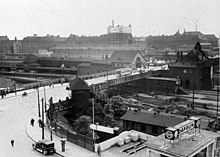Warsaw Bridge
Coordinates: 52 ° 30 ′ 23 " N , 13 ° 26 ′ 58" E
| Warsaw Bridge | ||
|---|---|---|
| use | Road traffic, public transport | |
| Convicted | Warschauer Strasse | |
| Crossing of | Eastern Railway , Silesian Railway | |
| place | Berlin-Friedrichshain | |
| overall length | 224.83 m | |
| width | 27.64 m | |
| height | 1.55 m | |
| start of building | 1872, 1938, 1994 | |
| completion | 1997 | |
| opening | 1875, 1997 | |
| location | ||
|
|
||
The bridge Warsaw is a road bridge in Berlin , in the Friedrichshain-Kreuzberg during the Warsaw street on the Eastern Railway and the Silesian railway leads.
It was the venue for the vegetable battle until 2013 .
history
bridge

On the Warschauer Brücke, Warschauer Strasse crosses almost at right angles the tracks of the railway, which were built by the Prussian Eastern Railway and the Lower Silesian-Märkische Railway in the 19th century. At this point, the railway line from Frankfurt (Oder) , which was opened in 1842, was the only one of the newly built railway lines to pass through the customs wall into the city area. In 1872 about 30 tracks crossed Warschauer Strasse here. The construction of the bridge became essential in order to be able to use both the road and the railway line as a traffic artery. The bridge was completed by 1875, but in the following years it was repeatedly rebuilt and expanded. Up until the mid-1930s, the iron structure was severely corroded by the steam from the steam locomotives , which made a replacement building necessary. This took place west of the existing bridge from 1938 first on the northern part and was interrupted by the beginning of the Second World War.
In 1945 the newly built part of the bridge collapsed as a result of a bomb hit and made the Warsaw Bridge impassable. It was only opened to traffic again in 1948. A repair was carried out in 1952/1953, another in 1955. A general repair was carried out in 1966/1967. After another major overhaul and reinforcement from 1994 to 1997 with the support of the European Regional Development Fund , the tram was also able to pass the bridge again.
The Edge East Side Tower is being built to the south .
Train
The original railway system is no longer preserved today. The station building of the former Silesian freight station , built in 1910, and the one-storey service building built in 1900, stood at the south-western end of the bridge until around 2004 . All the buildings in this area have now been completely removed in favor of the O 2 World, which was completed in 2008 and is now the Mercedes-Benz Arena .
The Warschauer Straße S-Bahn station is located on the eastern side of the bridge . The first station building stood at this point between 1884 and 1903, and was replaced by a building on the opposite side between 1903 and 1924. In 1924 a new reception building was built at the original location, designed by Richard Brademann . This station building and the platform entrances were largely removed by April 2005. The new construction of the station began in December 2011 and will be carried out in the course of construction work on the Ostbahnhof - Ostkreuz station . The work should be completed in 2016, but was stopped in 2015 and is subject to re-planning. The platforms were completed in 2017, the construction of a new station building will probably take place later.
Subway
The Warschauer Brücke underground station went into operation on August 17, 1902, and was built by Paul Wittig on behalf of Siemens & Halske . It was the terminus of the first Berlin underground and elevated railway line , today's U1 line . In the Second World War seriously damaged, the station was subsequently rebuilt. After the Wall was built in 1961, the station remained closed without any connection to the rest of the Berlin subway network; since 1995, trains have been running again to the renovated subway station, which has since been known as the Warschauer Straße subway station. Plans to relocate the underground station over the S-Bahn station of the same name to make it easier to change trains are not being pursued any further. Only the extension of the pedestrian walkway from the underground station to the new station building of the S-Bahn is still planned by the Berlin Senate .
More than 85,000 people change trains every day at the Warschauer Straße junction - which includes the underground , S-Bahn and trams .
literature
- Eberhard Heinze, Eckhard Thiemann, Laurenz Demps: Berlin and its bridges . 1st edition. Transpress, Berlin 1987, ISBN 3-344-00105-1 , p. 219-220 .
Web links
Individual evidence
- ↑ ÜberBücken: Bridge construction 1990–1999 - Warschauer Brücke. Senate Department for Urban Development and the Environment, accessed on July 8, 2012 .
- ↑ New construction of the Warschauer Straße S-Bahn station is delayed . In: Der Tagesspiegel . April 27, 2015.
- ^ Peter Neumann: Warschauer Strasse S-Bahn station will remain a construction site for months. In: Berliner Zeitung . July 16, 2020, accessed July 18, 2020 .
- ↑ Switching made easy. In: Der Tagesspiegel . January 14, 2013, accessed January 14, 2013 .
- ↑ A new face for Warschauer Strasse . In: point 3 . No. 1 , 2013, p. 12 f . ( online [accessed January 14, 2013]).

